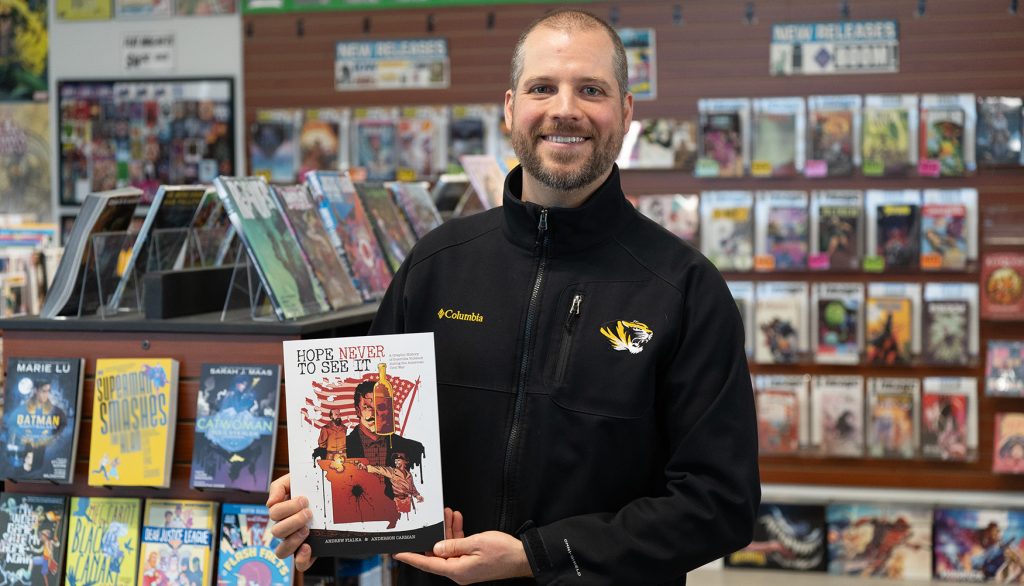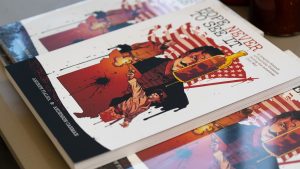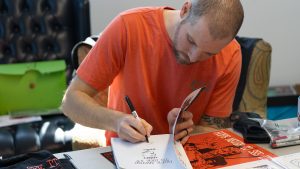
Story and photos by Logan Jackson
As Andrew Fialka’s junior year at Mizzou was coming to a close, he was struggling to come up with an engaging honors thesis idea to finish out his history degree. A chance encounter after the Mizzou men’s basketball captured the Big 12 tournament title sparked not only a thesis idea, but a decade-long passion.
“I was out celebrating – like so many of my peers were – and I happened to run into Joseph Beilein, was who a teaching assistant in history and had become a really good friend,” said Fialka, who graduated from Mizzou with a history degree in 2010. “We were standing in front of the Columns talking about a variety of things, and I brought up that I was having a hard time finding a thesis idea. He let me know that there was something he found in the archives that he didn’t have time for, but I might find interesting. I ran over to Ellis Library the next morning and pulled on a thread that just kept unraveling.”
That thread was tied to Jacob W. Terman, who terrorized mid-Missouri citizens as a spy throughout the American Civil War. Terman, who used the alias Harry Truman, went on a two-week-long murder spree targeting Missourians, claiming to be avenging the deaths of his family. Fialka became fascinated with how Missourians lives were affected during this turbulent time and soon had a plan for his thesis. He eventually finished a case study of the Union military’s adoption of guerrilla tactics in Civil War Missouri. That study was centered around Terman.

While Fialka left Mizzou after finishing his undergraduate degree to pursue a master’s degree at West Virginia University, he just couldn’t leave Terman or Civil War Missourians behind. He continued to study the impact of guerrillas on the Civil War at West Virginia and expanded on that work during his Ph.D. at the University of Georgia.
“I wrote this original analysis, but I was still learning so much about Terman and Missourians during this time period,” Fialka said. “The work helped me get into graduate school, but the writings weren’t published or anything. I kept telling snippets of Terman’s story throughout my academic career. It was actually my wife who kept encouraging me and telling me that I wasn’t done with the guy, it was too important.”
Fialka eventually found the perfect outlet to expand on Terman and showcase what many mid-Missourians dealt with during the Civil War – a graphic history. His book, titled, Hope to Never See It: A Graphic History of Guerrilla Violence during the American Civil War, was published earlier this year.
“I’d never been exposed to graphics until someone gave me Watchmen,” Fialka said. “It was the first graphic novel that I ever read, and all the light bulbs started going off for me after reading it. I realized that this type of storytelling could be done seriously and for an adult audience. Everything sort of fell into place and it all clicked. I knew I had found the perfect outlet to share this story.”
Hope to Never See It is much more than just a look at Terman. Fialka’s story weaves the life of Terman with “Bloody” Bill Anderson, an infamous Confederate guerrilla who was responsible for the deaths of nearly 150 United States troops. Although Terman and Anderson serve as primary characters, Fialka wanted to make sure that central Missourians stayed at the center of his work.
“While there are two primary characters, I wanted this to be more about how mid-Missourians experienced the war,” Fialka said. “The main characters frame the story, but the true focus is on central Missouri. I wanted to share what those civilians suffered during both tragedies. If I was going to do justice to their experiences, I had to talk about the worst things that they went through.”
Fialka and the graphic history’s artist, Anderson Carman, recently completed a tour that showcased the work across several states. He even made a stop back in Columbia, meeting with individuals and signing books at Distant Planet Comics and Collectibles.
“Being able to bring the book back to Columbia was definitely a full-circle moment,” Fialka said. “The story started here, and it was amazing to bring a finished product back.”

There was little doubt that Fialka was going to be a Tiger. With parents who both earned degrees from Mizzou, as well as a sister, Fialka said he didn’t even apply to another university.
“My dad started taking me to football games when I was young,” Fialka said. “I had no desire to go anywhere else. All I knew was black and gold.”
Fialka was originally interested in pursuing an engineering degree. However, a class with Steven Watts, a professor emeritus of history, opened the door for Fialka to switch programs.
“Professor Watts taught an introductory level history course, and I was blown away,” Fialka said. “I was hanging on every word – it wasn’t the history I had learned in high school. I soon learned that the faculty in history were incredible, so I made the decision to switch over.”
Along with his history degree, Fialka was incredibly involved in the Honors College.
“There’s a certain electricity that is present when you attend a sporting event or concert, but I had never felt that in an educational setting until I joined the Honors College,” Fialka said. “I loved the environment that my Honors courses provided me; it was great to interact in a meaningful way with my peers and the professors.”
Fialka earned his master’s degree in history from West Virginia University in 2013 and his Ph.D. in history from the University of Georgia in 2018. It was actually the University of Georgia Press that printed Fialka’s graphic history.
“This format is fairly unique – there are only a couple other graphic history publications out there,” Fialka said. “I’m really thankful that the University of Georgia was willing to take a chance on this. They gave us the artistic license that we were looking for and let us share the vision that was in our heads.”
Fialka, who is currently an associate professor of history at Middle Tennessee State University, has plans for similar graphic histories, too.
“I grew up loving music, especially punk rock,” Fialka said. “I refused to listen to anything else. Now, though, I take in everything. Give me hip hop, give me pop or country. I’m at that point with books and literature, too. Graphic novels are the latest form that I’m taking in. It’s an awesome storytelling outlet, and I’m at the point in my career where I’m open to appreciating these different styles.”
Whether in the classroom or writing stories, the lessons Fialka learned at Mizzou and through the Honors College seep through his work. He said he’s grateful for the willingness of faculty to invest in each student.
“I’m definitely an example of how the work that the Honors College is doing with students is paying off down the road,” Fialka said. “My experiences at Mizzou truly changed my life, especially those with my professors, whether in Honors or history. When I walk into the classroom to teach, I’m focused on paying it forward because so many professors made a huge difference for me.”